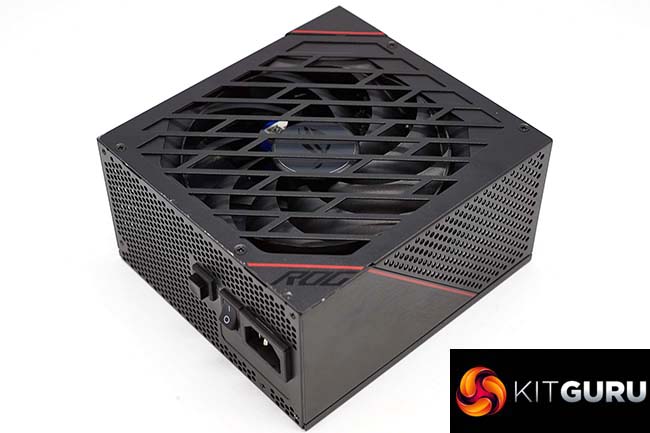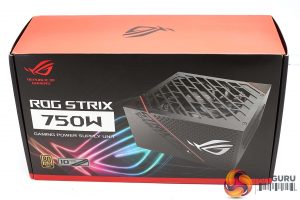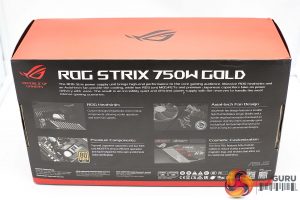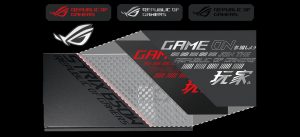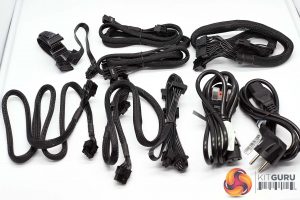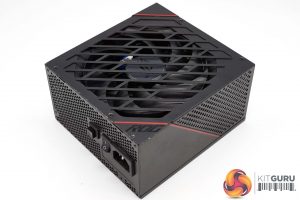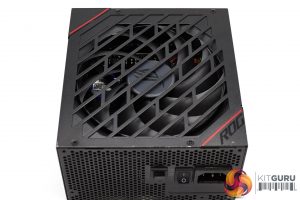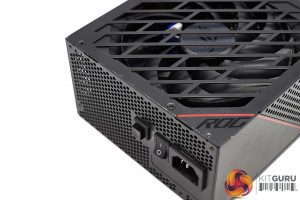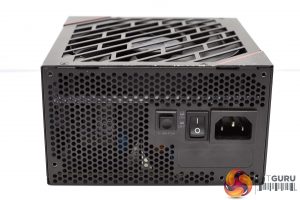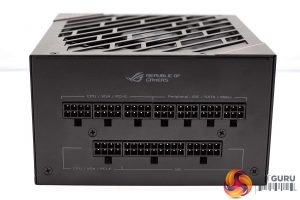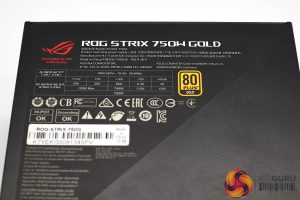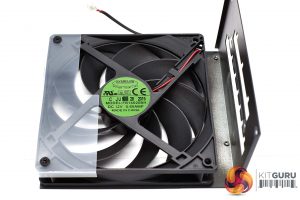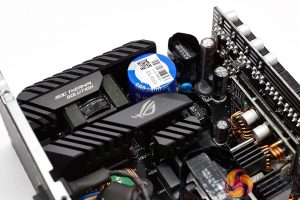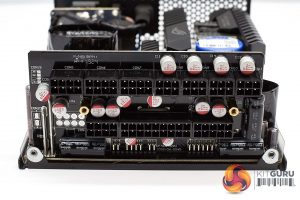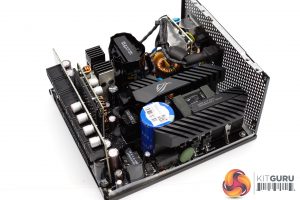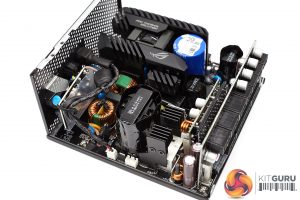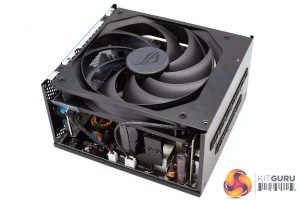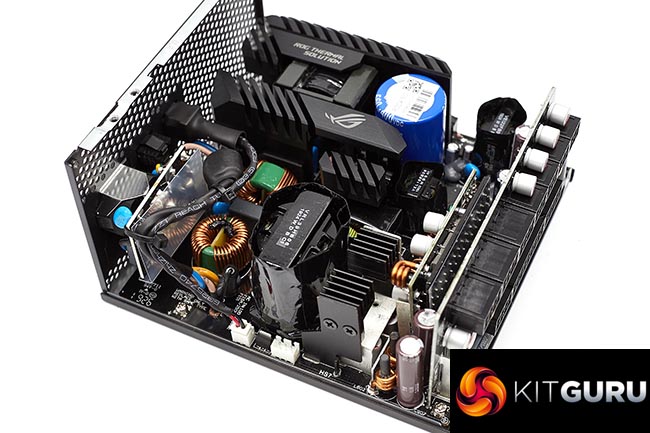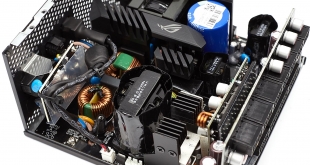
ASUS have added a 650 Watt and 750 Watt unit to their latest Republic Of Gamers range of power supplies. These 80 Plus Gold Certified units target the discerning enthusiast audience and today we are analysing the 750 watt model.
The fully modular power supplies ship with a 10 year warranty for peace of mind.
Asus sent us this review sample from one of their own system builds, samples seem very limited right now in the UK. We would imagine their OEM partner is Seasonic again, after our earlier review of the THOR power supply back in 2018. We will look at this in detail later in the review.
- ROG heatsinks cover critical components. Lower temps result in a longer lifespan and reduced noise.
- Axial-tech fan design features a smaller fan hub that facilitates longer blades and a barrier ring that increases downward air pressure.
- Dual ball fan bearings can last up to twice as long as sleeve bearing designs.
- 0dB Technology lets you enjoy light gaming in relative silence.
- An 80 Plus Gold Certification is the result of Japanese capacitors and other premium components.
- Cosmetic customization is enabled by a magnetic logo and stickers that help you reskin the visible side to your liking.
- Fully modular cables keep your rig neat and tidy.
- 10-year warranty included.
The box for the ASUS ROG Strix 750W power supply is quite effective and rather attractive. We like the RGB/Rainbow style logo bottom left and the high resolution image of the power supply on the right side.
Asus are highlighting four key elements on the rear of the box.
- ROG Heatsinks – their custom designed heatsinks which cover ‘critical components' in the design. Helping to reduce noise and to enhance component life.
- Premium Components – The adoption of ASUS ROG to use Japanese Capacitors and low RDS MOSFETS.
- Axial-Tech Fan Design – They are using a smaller hub fan design to facilitate longer fan blades. They say they are using a ‘barrier ring' to increase downward air pressure. Its a Dual ball fan bearing design for long life.
- Cosmetic Customisation – The fully modular design is a noteworthy feature, as it allows the end user to use only the cables he or she needs for the system build. They also discuss the magnetic logo and stickers.
The bundle with the power supply is quite substantial. Asus include a mixture of plastic and felt cable ties, stickers and the magnetic logo, along with literature on the product, regional specific power connectors, and mounting screws.
The video above shows you all the areas you can ‘tweak' to your colour preference. A good move by ASUS in our opinion as more and more people are creating colour themed system builds every year.
Power Cord x 1
Motherboard Power cable x 1
CPU Cable 1000mm x 2
PCI-E Cable x 2
SATA Cable x 2
Peripheral x 1
All the cables for this power supply are braided with our particular sample shipping with two power plugs, one for UK and the other for EU.
The ASUS ROG STRIX 750W Gold power supply measures 160 x 150 x 86 mm it weighs 1.82kg. It is nicely finished in line with what we would expect from a ROG product.
A large fan is hidden behind a grille – we will take a closer look at the fan when we open the unit later in the review.
Our sample arrived with some marks on the chassis – Asus told me they used it in a UK build before they shipped it to me, and that they wanted it back after my review.
One side of the PSU is home to the cooling vent, power connector, power button and silent mode button (or as Asus call it ‘odB Technology'.
The other side of the power supply is home to the modular bay – all clearly labelled across two rows.
| Asus ROG STRIX 750W Power Supply | |||||
|
DC Output
|
+3.3V
|
+5V
|
+12V |
-12V
|
+5Vsb
|
|
Max Output
|
20A
|
20A
|
62A |
0.3A
|
3.0A
|
| Total Power | 100W | 744W | 3.6W | 15W | |
| 750W | |||||
The Asus ROG STRIX 750W Gold Power Supply is able to deliver 62A on the +12V rail, for 744 watt of the total power load.
ASUS are using an ‘everflow' fan, a dual ball bearing model marked ‘FB14025BH' rated 12V 0.60 AMP.
Asus wanted the power supply back after I had tested it, so I didn't take it completely apart, as I usually do. I am stunned that they only seem to have one sample in the UK right now of this particular power supply.
Having looked at this unit I can see that it is a modified version of the Seasonic Focus Plus Gold Platform. This is a quality, reliable, technically sophisticated platform which we have reviewed in the past, and regard very highly.
Input filtering starts on a small PCB with Y and X capacitors in place – moving to the main PCB for completion. Inside are a fair few smallish heatsinks to aid with cooling key components. The power supply is using a full bridge LLC topology with synchronous rectification with DC-DC VRM’s for +3.3V and +5V rails on secondary.
Asus are using bigger heatsinks to likely try and reduce noise levels. By memory the PCB looks to be a bit bigger too. Asus are using high grade 105c rated Japanese capacitors throughout the design with the primary hold up capacitor rated 560uF 400V @ 105C.
Correctly testing power supplies is a complex procedure and KitGuru have configured a test bench which can deliver up to a 2,000 watt DC load.
Due to public requests we have changed our temperature settings recently – previously we rated with ambient temperatures at 25C, we have increased ambient temperatures by 10c (to 35c) in our environment to greater reflect warmer internal chassis conditions.
We use combinations of the following hardware:
• SunMoon SM-268
• CSI3710A Programmable DC load (+3.3V and +5V outputs)
• CSI3711A Programmable DC load (+12V1, +12V2, +12V3, and +12V4)
• Extech Power Analyzer
• Extech MultiMaster MM570 digital multimeter
• Extech digital sound level meter
• Digital oscilloscope (20M S/s with 12 Bit ADC)
• Variable Autotransformer, 1.4 KVA
|
DC Output Load Regulation
|
||||||||||
|
Combined DC Load |
+3.3V
|
+5V
|
+12V
|
+5VSB
|
-12V | |||||
|
A
|
V
|
A
|
V
|
A
|
V
|
A
|
V
|
A | V | |
|
75W
|
0.95
|
3.34
|
0.93
|
5.03
|
5.13
|
12.06
|
0.50
|
5.02
|
0.20
|
-12.05
|
|
150W
|
1.65 |
3.34
|
1.66
|
5.02
|
10.61
|
12.05
|
1.00
|
5.02
|
0.20
|
-12.04
|
|
375W
|
3.00
|
3.34
|
3.02
|
5.02
|
28.11
|
12.05
|
1.50
|
5.01
|
0.30
|
-12.04
|
| 565W |
4.05
|
3.34
|
4.07
|
5.01
|
42.94
|
12.04
|
2.00
|
5.00 |
0.30
|
-12.04
|
|
750W
|
4.90
|
3.33
|
5.24
|
5.01
|
57.48
|
12.02
|
2.50
|
5.00
|
0.50
|
-12.04
|
Load regulation proves to be excellent, holding within 1.5%.
| Asus ROG STRIX 750W | Maximum Load |
| 841W |
We managed to reach around 841W before the unit would shut down gracefully, after the protection kicked in. This is around 91 watts more than the rated output.
Next we want to try Cross Loading. This basically means loads which are not balanced. If a PC for instance needs 500W on the +12V outputs but something like 30W via the combined 3.3V and +5V outputs then the voltage regulation can fluctuate badly.
| Cross Load Testing | +3.3V | +5V | +12V | -12V | +5VSB | |||||
| A | V | A | V | A | V | A | V | A | V | |
| 734W | 1.0 | 3.34 | 1.0 | 5.02 | 60.0 | 12.01 | 0.2 | -12.03 | 0.50 | 5.02 |
| 154W | 15.0 | 3.33 | 15.0 | 4.97 | 2.0 | 12.06 | 0.2 | -12.03 | 0.50 | 5.01 |
The unit passes our Cross Load testing without any problems. When hit with 60 AMPS the +12V rail held at 12.01 which is a reference result. It is unlikely in a real life situation you would be doing this, but its good to see the design is holding up extremely well under demanding situations.
We then used an oscilloscope to measure AC ripple and noise present on the DC outputs. We set the oscilloscope time base to check for AC ripple at both high and low ends of the spectrum.
ATX12V V2.2 specification for DC output ripple and noise is defined in the ATX 12V power supply design guide.
|
ATX12V Ver 2.2 Noise/Ripple Tolerance
|
|
|
Output
|
Ripple (mV p-p)
|
|
+3.3V
|
50
|
|
+5V
|
50
|
|
+12V1
|
120
|
|
+12V2
|
120
|
|
-12V
|
120
|
|
+5VSB
|
50
|
Obviously when measuring AC noise and ripple on the DC outputs the cleaner (less recorded) means we have a better end result. We measured this AC signal amplitude to see how closely the unit complied with the ATX standard.
| AC Ripple (mV p-p) | ||||
| DC Load | +3.3V | +5V | +12V | 5VSB |
| 75W | 5 | 5 | 10 | 5 |
| 150W | 5 | 5 | 15 | 5 |
| 375W | 5 | 5 | 20 | 5 |
| 565W | 5 | 5 | 20 | 5 |
| 750W | 10 | 5 | 25 | 5 |
Noise suppression results are superb, peaking at 10mV on the +3.3V and 5mV on the +5V rail under full load. The +12V rail peaks at 25mV under full load conditions. A fantastic showing all round.
|
Efficiency (%) 240V
|
|
|
75W
|
89.4
|
|
150W
|
91.3
|
|
375W
|
92.5
|
|
565W
|
91.8
|
|
750W
|
90.6
|
Efficiency is good for an 80 Plus Gold unit, peaking at around 92.5% at 50% load. At full load the power supply maintains an 90.6% efficiency level, which is impressive.
We take the issue of noise very seriously at KitGuru and this is why we have built a special home brew system as a reference point when we test noise levels of various components. Why do this? Well this means we can eliminate secondary noise pollution in the test room and concentrate on components we are testing. It also brings us slightly closer to industry standards, such as DIN 45635.
Today to test the power supply we have taken it into our acoustics room environment and have set our Digital Sound Level Noise Decibel Meter Style 2 one meter away from the unit. We have no other fans running so we can effectively measure just the noise from the unit itself.
As this can be a little confusing for people, here are various dBa ratings in with real world situations to help describe the various levels.
KitGuru noise guide
10dBA – Normal Breathing/Rustling Leaves
20-25dBA – Whisper
30dBA – High Quality Computer fan
40dBA – A Bubbling Brook, or a Refrigerator
50dBA – Normal Conversation
60dBA – Laughter
70dBA – Vacuum Cleaner or Hairdryer
80dBA – City Traffic or a Garbage Disposal
90dBA – Motorcycle or Lawnmower
100dBA – MP3 Player at maximum output
110dBA – Orchestra
120dBA – Front row rock concert/Jet Engine
130dBA – Threshold of Pain
140dBA – Military Jet takeoff/Gunshot (close range)
160dBA – Instant Perforation of eardrum
|
Noise (dBA)
|
|
|
75W
|
<28.0
|
|
150W
|
<28.0
|
|
375W
|
30.7
|
|
565W
|
31.8
|
| 750W | 33.4 |
The fan in this unit is very quiet under most load conditions, and it is only in the last 10% of power delivery that the fan starts to spin up to compensate for rising heat. The ASUS beefed up heatsink design really works well, even for a modestly efficient (in 2019 anyway) '80 Plus Gold' rated unit.
|
Temperature (c)
|
||
|
Intake
|
Exhaust
|
|
|
75W
|
36
|
39
|
|
150W
|
38
|
44
|
|
375W
|
39
|
47
|
|
565W
|
45
|
55
|
|
750W
|
47
|
58
|
The large dual ball bearing fan works well to expel heat out the rear of the chassis. The overall results are very good indeed.
|
Maximum load
|
Efficiency
|
|
841W
|
90.3
|
At 841 watts, the efficiency level measures 90.3%. Not a practical situation to be running 24/7, but worth noting.
The Republic Of Gamers line up is a very important brand for ASUS. Its specifically targeting the discerning enthusiast user willing to spend a premium to get the best possible performing products. ASUS' decision to partner up with market leader Seasonic was an excellent decision. Seasonic products have consistently scored well in KitGuru reviews over the last decade and they remain our highest award winning power supply manufacturer.
This is not a generic Seasonic product however. ASUS have bought into the FOCUS + platform and made some modifications. ASUS have invested time and resources into beefing up the PCB and heatsink design, which in turn means better passive cooling capabilities. The all important real world results indicate that this is a very quiet power supply, even when delivering up to 650 watts of constant power over sustained conditions. By beefing up the cooling capabilities you are buying into what we would consider the best 80 Plus Gold platform available to the consumer right now.
Technically, we already know how good Seasonic's FOCUS platform is. We have tested the power supplies in the past and they are class leading in regards to ripple suppression and load regulation. The capacitors are 105c rated, high grade Japanese, and with the enhanced cooling inside, we would imagine this unit will last a long time. ASUS do offer a 10 year warranty with the unit for peace of mind.
Right now we have no links to buy the product, but we know after speaking with Overclockers UK that they will have the unit in stock very shortly at around the £139.99 price point. I will update the review once I get more buying information and links.
Pros:
- Very high quality Seasonic platform – modified and enhanced by ASUS.
- fantastic heatsink design.
- quite under load.
- Japanese capacitors.
- cosmetic customisation options will appeal to many.
- delivered close to 850W under extreme load before shutting off safely.
- technically very solid.
- 10 year warranty.
Cons:
- its expensive.
Kitguru says: This is one of the finest 80 Plus Gold power supplies on the market in 2019. ASUS have modified and enhanced an already very capable Seasonic platform. Its expensive, but if you want the ultimate in quality and component selection, the ROG STRIX 750W deserves serious consideration.
 KitGuru KitGuru.net – Tech News | Hardware News | Hardware Reviews | IOS | Mobile | Gaming | Graphics Cards
KitGuru KitGuru.net – Tech News | Hardware News | Hardware Reviews | IOS | Mobile | Gaming | Graphics Cards


